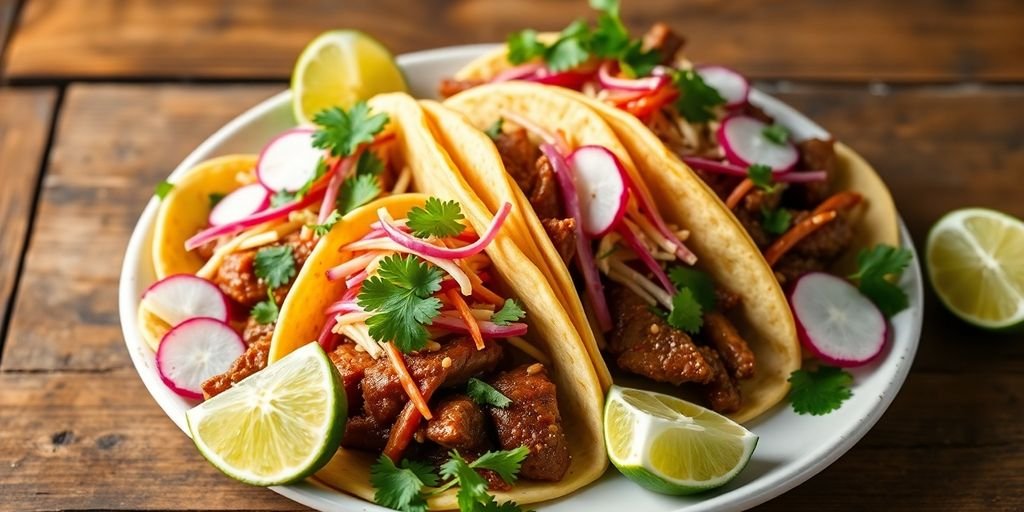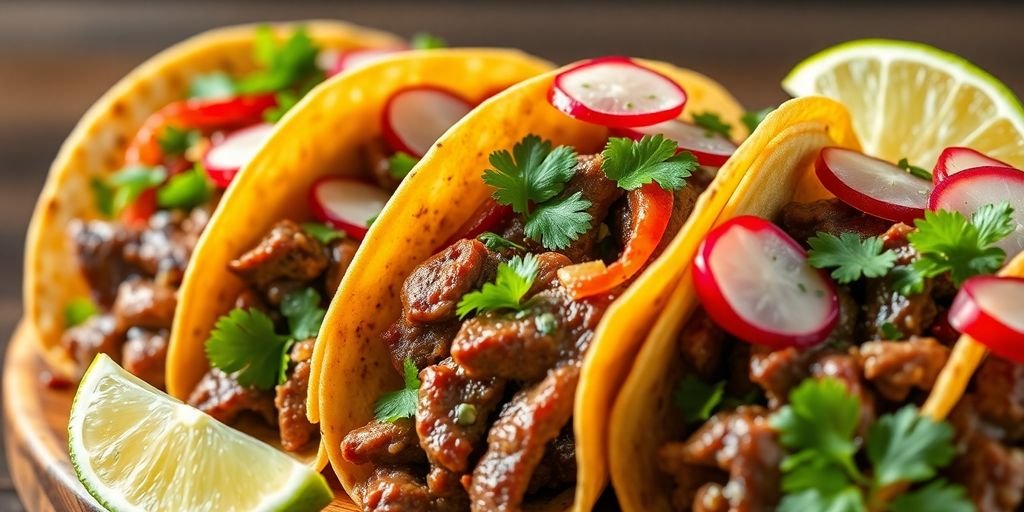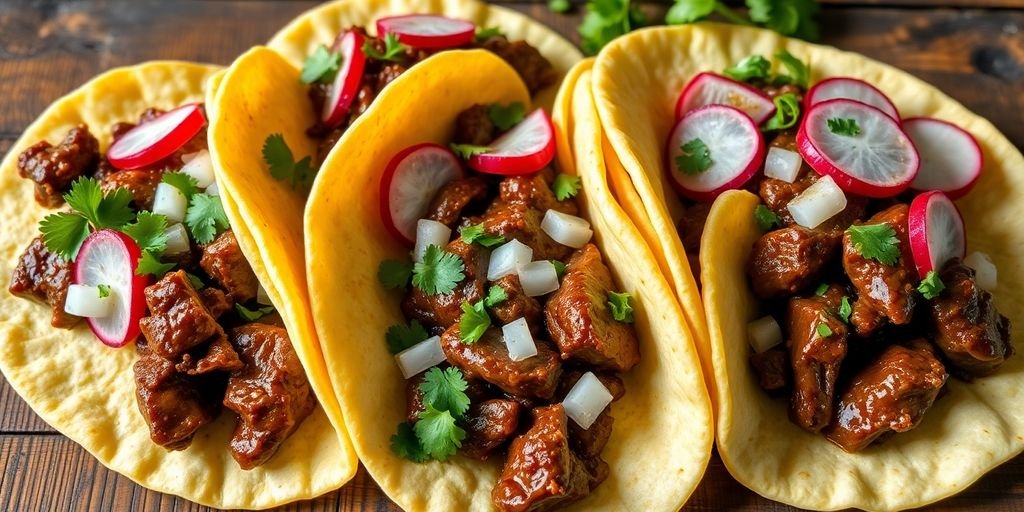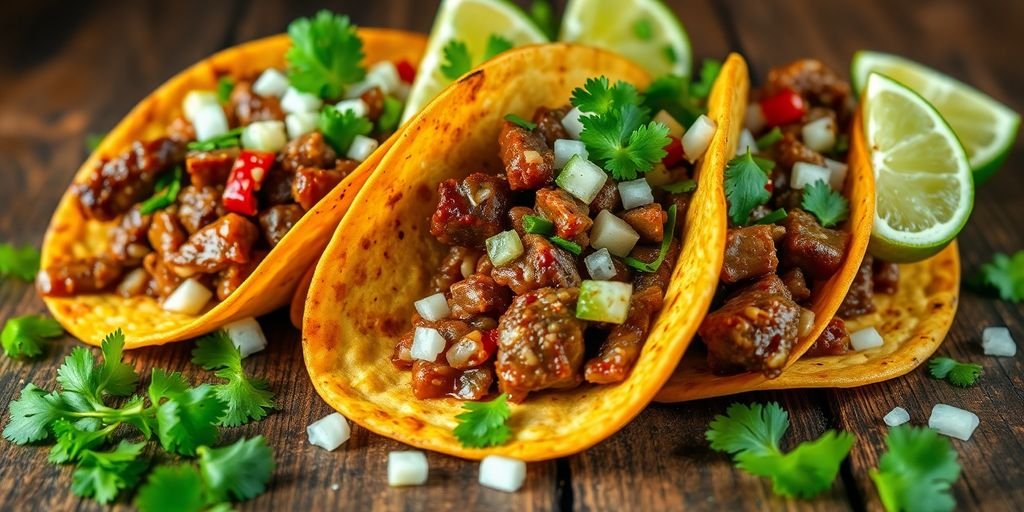
Korean beef tacos are a delicious blend of two fantastic cuisines—Korean and Mexican. Imagine marinated beef bulgogi wrapped in a soft taco shell, topped with spicy kimchi and fresh cilantro. This dish brings together the rich flavors of Korean barbecue with the vibrant zest of Mexican street food. Whether you’re a fan of Korean food or a taco lover, these fusion tacos are sure to be a hit at your next meal.
Key Takeaways
- Korean beef tacos combine the flavors of Korean barbecue with Mexican street food.
- The marinade for bulgogi typically includes soy sauce, garlic, and sesame oil.
- Kimchi adds a spicy kick to the tacos, balancing the savory beef.
- These tacos can be customized with various toppings like cilantro and lime.
- Korean beef tacos are a popular fusion dish enjoyed by many cultures.
The Fusion of Korean and Mexican Cuisines
Exploring the Origins of Korean Beef Tacos
Korean beef tacos are a delicious blend of two distinct culinary worlds. This fusion began in the bustling streets of Los Angeles, where food trucks started experimenting with bold flavors. Korean BBQ, known for its sweet and savory notes, found a perfect partner in the versatile Mexican taco. The result? A mouthwatering creation that combines the best of both worlds, with the rich taste of bulgogi nestled in a soft tortilla.
Cultural Influences in Fusion Cuisine
Fusion cuisine is all about bringing together different culinary traditions to create something new and exciting. In the case of Korean-Mexican tacos, the influence of Korean immigrants in the U.S. played a big role. They brought with them traditional recipes and adapted them using locally available ingredients. This blend is not just about taste but also a reflection of cultural exchange and adaptation.
Why Korean Beef Tacos Are a Hit
Korean beef tacos have become a sensation because they offer a unique taste experience. The combination of sweet, spicy, and tangy flavors, along with the crunch of fresh toppings, makes each bite an explosion of taste. People love the creativity behind this fusion and the way it brings together different textures and flavors. Plus, it’s a fun way to enjoy a meal that’s both familiar and exotic at the same time.
Essential Ingredients for Korean Beef Tacos
Choosing the Right Cut of Beef
Picking the right beef for your Korean tacos is crucial. You want something tender and flavorful. Flank steak is a popular choice because it absorbs marinades well and cooks quickly. Other good options include hanger steak, top sirloin, or flat iron steak. Make sure to thinly slice the beef against the grain to maximize tenderness.

The Role of Marinades in Flavor
Marinades are where the magic happens. They infuse the beef with a mix of sweet, savory, and slightly spicy flavors typical of Korean cuisine. A classic bulgogi marinade might include soy sauce, sesame oil, garlic, ginger, and brown sugar. Letting the beef marinate for at least four hours, or overnight if possible, allows the flavors to penetrate deeply, making each bite a taste explosion.
Key Toppings for Authentic Taste
Toppings are what make these tacos uniquely flavorful. Start with a crunchy base of purple cabbage for texture. Add fresh cilantro leaves for a burst of freshness and avocado slices for creaminess. Don’t forget a drizzle of taco sauce—mix sour cream, mayonnaise, Sriracha, and lime juice for a spicy, tangy kick. Optionally, squeeze some fresh lime juice over the top for extra zing.
Korean Beef Tacos are a delightful fusion of flavors, where each ingredient plays a crucial role in creating a memorable dish. Whether it’s the perfectly marinated beef or the vibrant toppings, every component is essential to the overall experience.
Step-by-Step Guide to Making Bulgogi Tacos

Preparing the Bulgogi Marinade
First things first, you gotta get that marinade just right. This is where all the magic happens. Grab a food processor and toss in an Asian pear, half an onion, a few cloves of garlic, a chunk of ginger, soy sauce, brown sugar, and a splash of sesame oil. Blend it until smooth. This sweet and savory mix is gonna soak into your beef, making it super flavorful. Let the thinly sliced beef chill in this marinade for at least two hours, but overnight is even better.
Cooking the Beef to Perfection
Alright, once your beef has marinated, it’s time to cook it up. Heat a bit of vegetable oil in a hot skillet. You want it really hot so the beef gets a nice sear. Cook the beef in batches, laying it flat in the pan and letting it sizzle until it’s crispy and caramelized on the outside. This should only take a couple of minutes per side. Once it’s done, set it aside.
Assembling the Perfect Taco
Now comes the fun part—putting it all together! Warm up some corn tortillas, either over an open flame or in a dry skillet. Lay down some shredded cabbage for crunch, then pile on the cooked bulgogi. Top it off with a bit of kimchi for that spicy kick, a dollop of sour cream, some crumbled queso fresco, and a sprinkle of fresh cilantro. Finish with a squeeze of lime juice.
These tacos are a fusion masterpiece, blending the rich flavors of Korean cuisine with the vibrant textures of Mexican street food. Perfect for a fiesta of taste with friends or a cozy night in.
Flavor Profiles of Korean Beef Tacos
Balancing Sweet and Savory
Korean beef tacos are a delightful mix of sweet and savory, thanks to the bulgogi marinade. The marinade usually includes soy sauce, brown sugar, and sesame oil, creating a deep, rich flavor profile. The sweetness from the sugar balances the saltiness of the soy sauce perfectly. The result is a harmonious blend that dances on your taste buds.
The Impact of Spicy Kimchi
Adding kimchi to your Korean beef tacos brings a spicy kick that many find irresistible. This fermented cabbage dish is a staple in Korean cuisine, known for its spicy, tangy flavor. When paired with the sweet and savory beef, it adds a layer of complexity that elevates the overall taste. If you’re a fan of heat, kimchi is an essential topping.
Adding Creamy Elements
To balance the spice and richness, creamy elements like avocado or a Sriracha-lime crema are often used. These ingredients cool down the heat from the kimchi and add a smooth texture to each bite. A drizzle of creamy sauce can make the difference between a good taco and a great one.
Combining these elements creates a taco experience that’s both familiar and exotic, satisfying cravings for something new yet comfortingly delicious.
Pairing Suggestions for Korean Beef Tacos

Beverage Pairings to Enhance Flavor
When it comes to finding the right drink to go with Korean beef tacos, you want something that complements the bold flavors without overpowering them. Craft beers like an IPA or a pale ale can work wonders, balancing the savory richness of the beef with their hoppy notes. If you’re more into wine, a chilled Riesling or a light Pinot Noir can add a nice contrast to the spicy and sweet elements in the tacos. For non-alcoholic options, a sparkling water with a splash of lime or a ginger beer can refresh your palate between bites.
Side Dishes to Complement the Tacos
Pairing Korean beef tacos with the right side dishes can elevate your meal from good to great. Consider serving them with a crisp Asian slaw that includes ingredients like napa cabbage and carrots tossed in a tangy sesame dressing. Another option is to add a side of pickled vegetables, such as radishes or cucumbers, which can provide a nice crunch and acidity. For something heartier, try a serving of steamed rice or a simple edamame salad.
Desserts to Complete the Meal
After enjoying the savory and spicy flavors of Korean beef tacos, a sweet finish can be the perfect ending. A light dessert like mango sorbet or green tea ice cream can cleanse the palate and provide a refreshing contrast. If you’re in the mood for something more indulgent, consider a slice of coconut cake or a few pieces of dark chocolate. These desserts offer a sweet note without being too heavy, making them an ideal way to wrap up your meal.
Finding the right pairings for your Korean beef tacos can transform a simple meal into an unforgettable culinary experience. Whether you choose a crisp beer, a tangy side, or a sweet dessert, each element plays a part in creating a well-rounded dining adventure.
Tips and Tricks for Perfect Korean Beef Tacos

Common Mistakes to Avoid
Making Korean beef tacos can be a fun culinary adventure, but there are some pitfalls you might want to dodge. One common mistake is not letting your beef marinate long enough. A quick marinade won’t infuse the meat with that deep, sweet-savory flavor you’re aiming for. Ideally, let it soak overnight. Another slip-up is cooking the beef straight from the fridge. Cold meat hitting a hot pan can lead to uneven cooking. Let it sit out for about 30 minutes before you start cooking. And don’t forget to toast those tortillas! A quick toast on a dry skillet makes all the difference, adding a nice crunch.
Time-Saving Techniques
If you’re pressed for time, there are a few shortcuts to consider. You can prepare your slaw and sauce ahead of time and store them in the fridge. This means when it’s taco time, all you need to do is cook the beef and assemble. Also, consider using pre-sliced beef or asking your butcher to slice it for you. This can save a good chunk of prep time. Lastly, marinate your beef in a large zip-top bag. It’s easy to mix and store, plus cleanup is a breeze.
Enhancing Flavor with Garnishes
Garnishes can really elevate your Korean beef tacos. Fresh cilantro adds a burst of color and flavor, while a squeeze of lime juice can brighten up the dish. Don’t shy away from adding some heat with sliced jalapeños or a drizzle of Sriracha. If you want a bit of creaminess, a dollop of sour cream or a sprinkle of crumbled cheese can do wonders. Remember, garnishes aren’t just for looks—they can add layers of flavor and texture to your tacos.
Perfecting Korean beef tacos is all about balancing flavors and textures. With a bit of planning and attention to detail, you can create a dish that’s not only delicious but also a feast for the eyes.
Variations and Customizations
Alternative Proteins for Bulgogi Tacos
Switching up the protein in your bulgogi tacos can lead to delightful surprises. Instead of the traditional beef, consider using chicken, pork, or even tofu for a vegetarian twist. Chicken thighs marinated in a similar sauce can offer a juicy and flavorful alternative. If you’re feeling adventurous, try using seafood like shrimp or fish, which can soak up the bulgogi marinade beautifully.
Vegetarian and Vegan Options
For those looking to skip the meat entirely, there are plenty of vegetarian and vegan options. Tofu and tempeh are fantastic meat substitutes that absorb the bulgogi marinade well. You can also use a variety of mushrooms, like portobello or shiitake, which provide a hearty texture and rich flavor. Pair these with vibrant veggies like bell peppers and zucchini to create a taco that’s both healthy and satisfying.
Creative Twists on Traditional Recipes
Why not give your bulgogi tacos a unique spin? Consider incorporating elements from other cuisines for a fusion feast. You could add pineapple slices for a sweet and tangy kick, reminiscent of Tacos Al Pastor. Or, introduce a layer of crunch with kimchi slaw or pickled radishes. For a creamy touch, try drizzling some avocado crema over the top. These creative twists can transform a familiar dish into something exciting and new.
Experimenting with different ingredients can breathe new life into your meals. Don’t be afraid to mix and match flavors to discover your perfect taco.
The Global Appeal of Korean Beef Tacos

Popularity Across Different Cultures
Korean Beef Tacos have become a global sensation, bringing together the best of Korean and Mexican flavors. This fusion dish has traveled far beyond its origins, capturing the hearts of food lovers worldwide. From the bustling streets of Los Angeles to the vibrant food markets of Seoul, these tacos have become a staple in many diverse culinary scenes. Their popularity is a testament to how food can transcend cultural boundaries, creating a shared experience that everyone can enjoy.
Adapting the Recipe for Local Tastes
One of the reasons Korean Beef Tacos are so beloved is their adaptability. Cooks around the world have put their own spin on the traditional recipe, incorporating local ingredients and flavors. In some places, you might find these tacos topped with locally sourced vegetables or unique sauces that reflect regional tastes. This adaptability not only makes the dish more accessible but also allows it to evolve, keeping it fresh and exciting for new audiences.
The Future of Fusion Cuisine
The success of Korean Beef Tacos is just the beginning for fusion cuisine. As more people become adventurous eaters, the demand for innovative dishes that combine different culinary traditions will continue to grow. This trend encourages chefs to experiment and push the boundaries of traditional cooking, resulting in creations that are both familiar and novel. Fusion cuisine is not just a passing trend; it’s a celebration of the endless possibilities that arise when cultures meet on a plate.
Korean Beef Tacos are a prime example of how food can bring people together, transcending cultural and geographical barriers to create something truly special. As this dish continues to gain popularity, it serves as a reminder of the power of food to unite us all.
Conclusion
So, there you have it, Korean-Mexican Bulgogi Tacos—a delightful fusion that brings together the best of both worlds. It’s amazing how these flavors blend so well, creating something truly unique and delicious. Whether you’re a fan of Korean BBQ or a taco enthusiast, this dish is sure to impress. Plus, it’s a fun way to shake up your usual taco night. Give it a try, and who knows, it might just become your new favorite go-to meal. Enjoy the adventure of flavors and happy cooking!

Frequently Asked Questions
What are Korean beef tacos made of?
Korean beef tacos are made with bulgogi-style beef, which is thinly sliced and marinated in a sweet and savory mix. They’re topped with ingredients like kimchi, avocado, and sometimes a creamy sauce.
How do you make the bulgogi marinade?
The bulgogi marinade is made by blending pear, onion, garlic, ginger, soy sauce, brown sugar, pepper, and sesame oil. This mix is used to marinate the beef for at least 2 hours.
What is bulgogi beef?
Bulgogi beef is a Korean dish featuring thinly sliced beef marinated in a flavorful sauce. It’s cooked until caramelized and is known for its sweet and savory taste.
Can I use a different protein for bulgogi tacos?
Yes, you can use different proteins like chicken or pork. Just make sure to adjust the cooking time and marinade accordingly.
What toppings go well with Korean beef tacos?
Common toppings include shredded cabbage, kimchi, cilantro, sour cream, queso fresco, and a squeeze of lime for added flavor.
Are there vegetarian options for Korean beef tacos?
Yes, you can make vegetarian versions by using tofu or mushrooms as the main filling, and marinating them in the same bulgogi sauce.

